Two New Ions: ASUS AT3N7A-I and ASRock Ion 330
by Anand Lal Shimpi on August 28, 2009 12:00 AM EST- Posted in
- Motherboards
Sidebar: ASRock Ion 330
Although today is all about ASUS’ entry into the Ion world with the AT3N7A-I, it’s also about picking your perfect Ion platform. I decided to round up the three Ion boards/systems currently on the market and compare them all as we evaluate the ASUS.
The Zotac Ion you already know about, we’ve covered it extensively and more recently looked at its latest PCB revision. The Ion platform you haven’t seen on AnandTech is ASRock’s Ion 330.
Unlike the ASUS and Zotac solutions, the ASRock Ion 330 is a complete system. For $379.99 you get a mini-ITX case, power supply, 2GB of memory, DVD drive and a 320GB hard drive - in addition to the ASRock Ion board. To give you an idea of scale I set the ASRock Ion 330 next to a standard 3.5” hard drive:
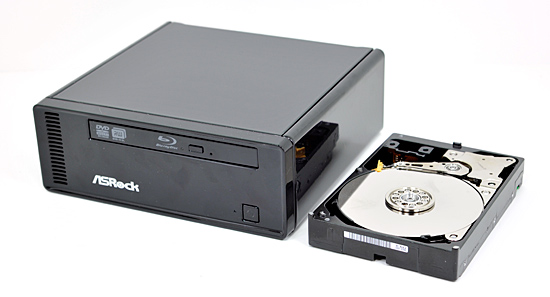
So, so sweet and small.
On the back of the ASRock Ion you get a healthy serving of 6 USB ports, VGA out, HDMI out, an Ethernet jack, three 1/8” audio jacks and optical audio out. There’s also a connector for the external 65W DC power supply. Despite this being 2009, there are no ports on the front of the chassis; it does keep things clean, but slightly inconvenient at the same time.
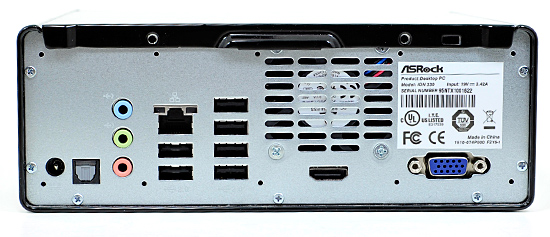
Inside there’s not much to see at first glance. Two screws hold the top cover on, removing them and sliding the cover back reveals the removable carrier that holds the slimline DVD drive and 2.5” HDD:
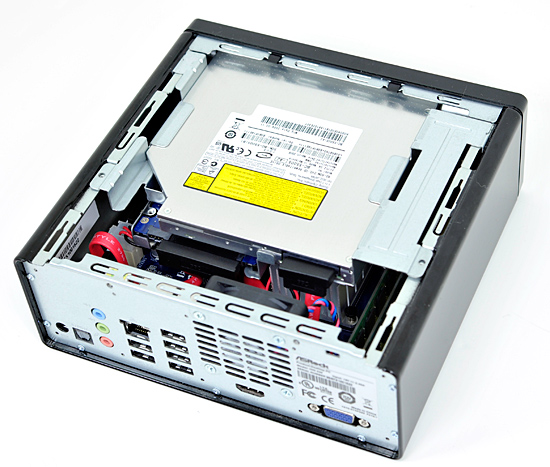
ASRock sent us the significantly more baller Ion 330-BD model, which forgoes the DVD drive for a slimline Blu-ray drive. The impact on price shouldn’t go unnoticed as the drive costs around $200 more than the standard DVD drive.
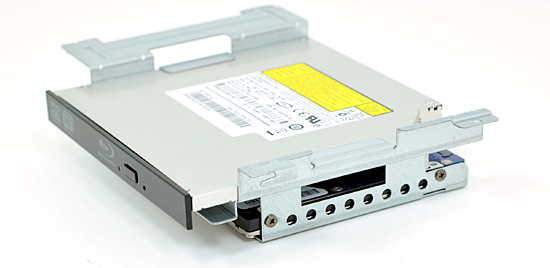
The slimline drive uses a mini-SATA power connector instead of standard SATA power. It’s supplied power somewhat crudely by a 4-pin 5V header on the motherboard that splits off and feeds both the optical drive and HDD.
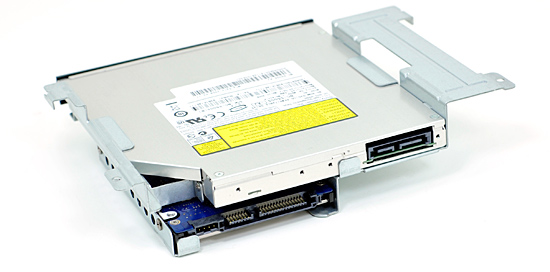
The hard drive is a standard 2.5” notebook drive. In this case it’s a 320GB Seagate Momentus 5400.6.
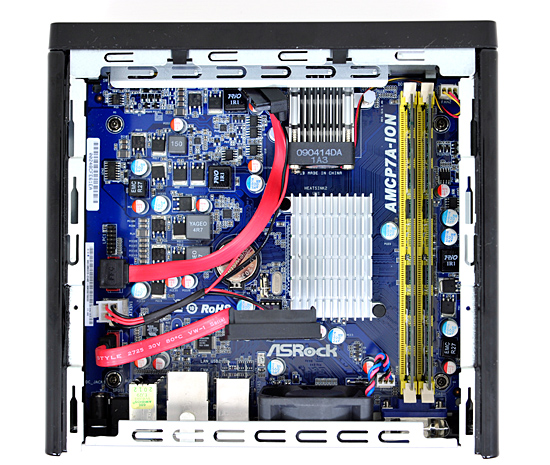
Below the drive carrier lies the motherboard itself and its two-fan cooling solution. A very small fan up front keeps the Atom processor cool. A larger fan in the back moves air around the rest of the chassis. The NVIDIA GPU doesn’t have a fan directly mounted to its heatsink and instead relies on the two fans to move heat off of its fins.
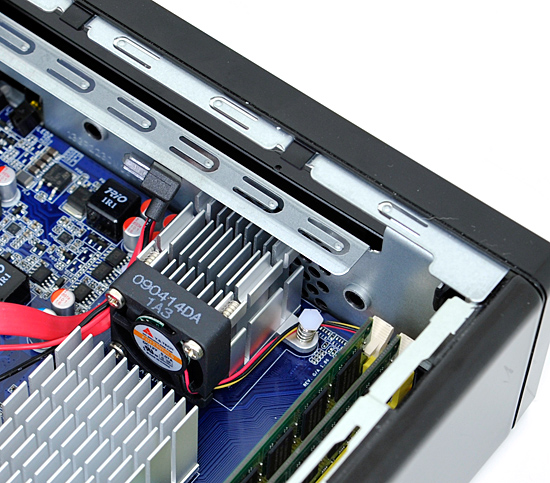
The smaller, and quieter CPU fan

The larger, and louder chassis fan
I hate to spoil the surprise, but the ASRock Ion 330 is built off of the same hardware as the ASUS and Zotac boards. You get a 1.6GHz dual-core Atom 330 combined with a NVIDIA GeForce 9300/9400M chipset. The result? Nearly identical performance.
The ASRock is nice from a convenience standpoint, all you do is buy the machine and load an OS on it. The major issues with it are a fan that isn’t silent (more on this later), and the fact that if you want to use an SSD in the machine you’re out $70 since it comes with a non-optional 2.5” HDD.










61 Comments
View All Comments
Titanius - Friday, August 28, 2009 - link
"While Acer offers the Aspire Revo, it only comes with a single-core Atom 230, a far less desirable option."What about the Acer Aspire Revo R3600? It has an Intel Atom 330, a 160GB HD and 2 GB of Dual-Channel RAM. Check it out: http://www.ncix.com/products/index.php?sku=41924&a...">http://www.ncix.com/products/index.php?...&man...
Fietsventje - Friday, August 28, 2009 - link
A pitty, no network interface benchmarks. Despite the overkill of the nVidia GPU, these boards would make the ideal start of a limited home server, and transferring files at gigabit speeds is no small feat for such a small processor ...mgrier - Friday, August 28, 2009 - link
Do you have data to support this? Between DMA both to the drive and the NIC and TCP checksum offloading, the CPU overhead of disk transfers should be minimal with an operating system and drivers that support all of the above. Assuming a single drive configuration, you should mostly be limited by transfer rate of the drive for large files. For smaller files, you should be limited by the drive's seek latency.JarredWalton - Saturday, August 29, 2009 - link
I'm not so sure it's the HDD CPU overhead so much as network drivers. I'd imaging these Atom CPUs could use a good 30-50% of the CPU for doing Gb transfers. However, as you are limited by the HDD to a maximum ~50MBps (unless you go SSD or at least a 7200RPM drive), you should probably only need 15-25% of the CPU. Would be interesting to see the results though. At least the Ion systems give you GbE, unlike all the netbooks I've tested.cliffman - Friday, August 28, 2009 - link
I am interested in seeing the performance of a mini-itx board that can support a quad core system. You can build a modern system for $500 instead of paying $350 for an atom system.MadMan007 - Sunday, August 30, 2009 - link
Considering those use any one of the regular LGA775 (atm - maybe we'll see some LGA1156 mITX boards) chipsets unless the board is just done poorly the performance would be the same as a full system with the same chipset and CPU. You'd just have the obvious tradeoff of expansion and possibly overclocking/enthusiast features.plext0r - Friday, August 28, 2009 - link
You mention the Acer Aspire Revo on the last page. Any word when and if Acer will release this box in the US? A single-core 230 is plenty of CPU horsepower for XBMC or MythTV when using Nvidia's binary drivers. Thanks!strikeback03 - Friday, August 28, 2009 - link
Hey, finally an Atom board with analog connections for more channels. Maybe I'll eventually replace the LF2 board in my carputer with this (and just keep the Scythe fan I already have).gipper - Friday, August 28, 2009 - link
Why in the world can't people just use bigger fixtures and bigger fans?It's like the xbox 360. Who cares if it's smaller than my receiver, it's A FREAKING JET ENGINE. Why can't they just bump the size up a bit and throw in a 120mm fan?
With these, what's wrong with bumping up the chasis to xbox1 size and going with a slower 80mm fan which will probably deliver more air flow at 800rpm than these 40mm fans at 6500rpm.
I can't believe that project leaders haven't caught on to this issue yet. They must have their quality assurance guys working in different rooms than the products they're testing, or they're testing them in the middle of the factory.
Abby - Wednesday, September 2, 2009 - link
For Manufacturing, Transportation and profits wise, small is da key.